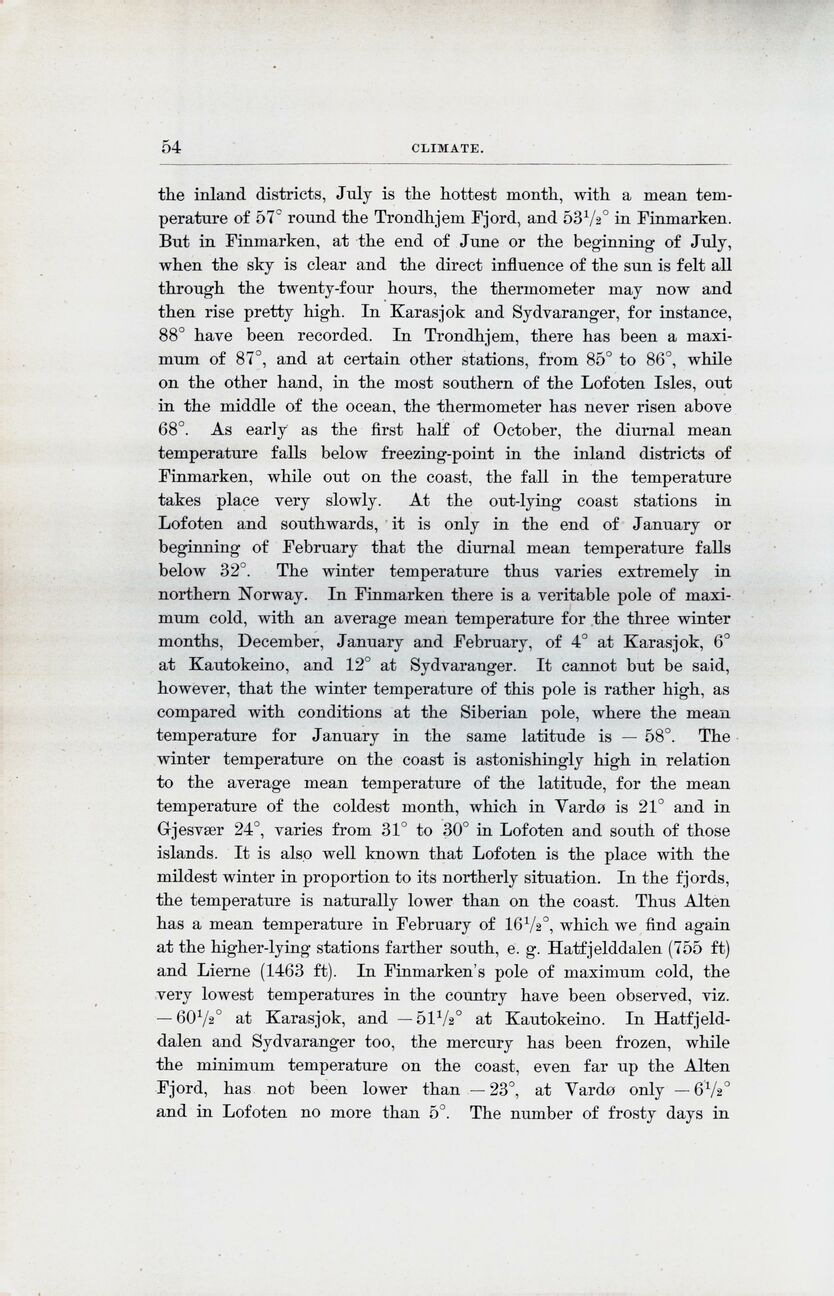
Full resolution (JPEG) - On this page / på denna sida - Climate, by Axel Steen

<< prev. page << föreg. sida << >> nästa sida >> next page >>
Below is the raw OCR text
from the above scanned image.
Do you see an error? Proofread the page now!
Här nedan syns maskintolkade texten från faksimilbilden ovan.
Ser du något fel? Korrekturläs sidan nu!
This page has been proofread at least once.
(diff)
(history)
Denna sida har korrekturlästs minst en gång.
(skillnad)
(historik)
the inland districts, July is the hottest month, with a mean
temperature of 57° round the Trondhjem Fjord, and 53 ½° in Finmarken.
But in Finmarken, at the end of June or the beginning of July,
when the sky is clear and the direct influence of the sun is felt all
through the twenty-four hours, the thermometer may now and
then rise pretty high. In Karasjok and Sydvaranger, for instance,
88° have been recorded. In Trondhjem, there has been a
maximum of 87°, and at certain other stations, from 85° to 86°, while
on the other hand, in the most southern of the Lofoten Isles, out
in the middle of the ocean, the thermometer has never risen above
68°. As early as the first half of October, the diurnal mean
temperature falls below freezing-point in the inland districts of
Finmarken, while out on the coast, the fall in the temperature
takes place very slowly. At the out-lying coast stations in
Lofoten and southwards, it is only in the end of January or
beginning of February that the diurnal mean temperature falls
below 32°. The winter temperature thus varies extremely in
northern Norway. In Finmarken there is a veritable pole of
maximum cold, with an average mean temperature for the three winter
months, December, January and February, of 4° at Karasjok, 6°
at Kautokeino, and 12° at Sydvaranger. It cannot but be said,
however, that the winter temperature of this pole is rather high, as
compared with conditions at the Siberian pole, where the mean
temperature for January in the same latitude is −58°. The
winter temperature on the coast is astonishingly high in relation
to the average mean temperature of the latitude, for the mean
temperature of the coldest month, which in Vardø is 21° and in
Gjesvær 24°, varies from 31° to 30° in Lofoten and south of those
islands. It is also well known that Lofoten is the place with the
mildest winter in proportion to its northerly situation. In the fjords,
the temperature is naturally lower than on the coast. Thus Alten
has a mean temperature in February of 16 ½°, which we find again
at the higher-lying stations farther south, e. g. Hatfjelddalen (755 ft)
and Lierne (1463 ft). In Finmarken’s pole of maximum cold, the
very lowest temperatures in the country have been observed, viz.
−60 ½° at Karasjok, and −51 ½° at Kautokeino. In
Hatfjelddalen and Sydvaranger too, the mercury has been frozen, while
the minimum temperature on the coast, even far up the Alten
Fjord, has not been lower than −23°, at Vardø only −6 ½°
and in Lofoten no more than 5°. The number of frosty days in
<< prev. page << föreg. sida << >> nästa sida >> next page >>